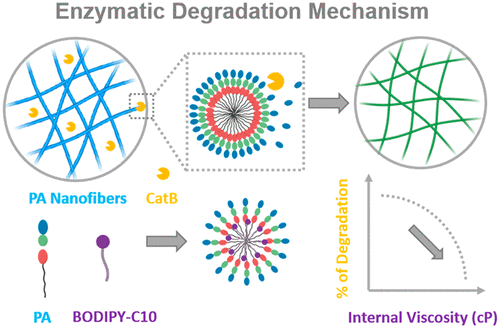当前位置:
X-MOL 学术
›
Nano Lett.
›
论文详情
Our official English website, www.x-mol.net, welcomes your
feedback! (Note: you will need to create a separate account there.)
Unravelling the Enzymatic Degradation Mechanism of Supramolecular Peptide Nanofibers and Its Correlation with Their Internal Viscosity.
Nano Letters ( IF 9.6 ) Pub Date : 2020-08-31 , DOI: 10.1021/acs.nanolett.0c02781 Yejiao Shi 1 , Peter A Summers 2 , Marina K Kuimova 2 , Helena S Azevedo 1
Nano Letters ( IF 9.6 ) Pub Date : 2020-08-31 , DOI: 10.1021/acs.nanolett.0c02781 Yejiao Shi 1 , Peter A Summers 2 , Marina K Kuimova 2 , Helena S Azevedo 1
Affiliation

|
Enzyme-responsive supramolecular peptide biomaterials have attracted growing interest for disease diagnostics and treatments. However, it remains unclear whether enzymes target the peptide assemblies or dissociated peptide monomers. To gain further insight into the degradation mechanism of supramolecular peptide amphiphile (PA) nanofibers, cathepsin B with both exopeptidase and endopeptidase activities was exploited here for degradation studies. Hydrolysis was found to occur directly on the PA nanofibers as only surface amino acid residues were cleaved. The number of cleaved residues and the degradation efficiency was observed to be negatively correlated with the internal viscosity of the PA nanofibers, quantified to be between 200–800 cP (liquid phase) using fluorescence lifetime imaging microscopy combined with an environmentally sensitive molecular rotor, BODIPY-C10. These findings enhance our understanding on the enzymatic degradation of supramolecular PA nanofibers and have important implications for the development of PA probes for the real-time monitoring of disease-related enzymes.
中文翻译:

揭示超分子肽纳米纤维的酶促降解机理及其与内部粘度的关系。
酶促超分子肽生物材料已引起人们对疾病诊断和治疗的日益增长的兴趣。然而,尚不清楚酶是靶向肽装配体还是解离的肽单体。为了进一步了解超分子肽两亲(PA)纳米纤维的降解机理,在这里利用同时具有肽外切酶和肽内切酶活性的组织蛋白酶B进行降解研究。发现仅在表面氨基酸残基被裂解时,水解直接在PA纳米纤维上发生。观察到裂解残基的数量和降解效率与PA纳米纤维的内部粘度呈负相关,使用荧光寿命成像显微镜和对环境敏感的分子转子BODIPY-C10结合,定量在200–800 cP(液相)之间。这些发现增强了我们对超分子PA纳米纤维的酶促降解的理解,并且对实时监测疾病相关酶的PA探针的开发具有重要意义。
更新日期:2020-10-15
中文翻译:

揭示超分子肽纳米纤维的酶促降解机理及其与内部粘度的关系。
酶促超分子肽生物材料已引起人们对疾病诊断和治疗的日益增长的兴趣。然而,尚不清楚酶是靶向肽装配体还是解离的肽单体。为了进一步了解超分子肽两亲(PA)纳米纤维的降解机理,在这里利用同时具有肽外切酶和肽内切酶活性的组织蛋白酶B进行降解研究。发现仅在表面氨基酸残基被裂解时,水解直接在PA纳米纤维上发生。观察到裂解残基的数量和降解效率与PA纳米纤维的内部粘度呈负相关,使用荧光寿命成像显微镜和对环境敏感的分子转子BODIPY-C10结合,定量在200–800 cP(液相)之间。这些发现增强了我们对超分子PA纳米纤维的酶促降解的理解,并且对实时监测疾病相关酶的PA探针的开发具有重要意义。











































 京公网安备 11010802027423号
京公网安备 11010802027423号